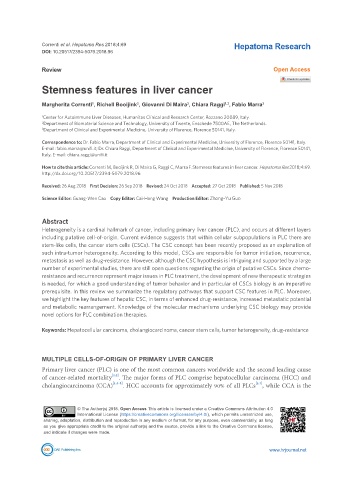Page 766 - Read Online
P. 766
Correnti et al. Hepatoma Res 2018;4:69 Hepatoma Research
DOI: 10.20517/2394-5079.2018.96
Review Open Access
Stemness features in liver cancer
1,3
3
2
Margherita Correnti , Richell Booijink , Giovanni Di Maira , Chiara Raggi , Fabio Marra 3
1
1 Center for Autoimmune Liver Diseases, Humanitas Clinical and Research Center, Rozzano 20089, Italy.
2 Department of Biomaterial Science and Technology, University of Twente, Enschede 7500AE, The Netherlands.
3 Department of Clinical and Experimental Medicine, University of Florence, Florence 50141, Italy.
Correspondence to: Dr. Fabio Marra, Department of Clinical and Experimental Medicine, University of Florence, Florence 50141, Italy.
E-mail: fabio.marra@unifi.it; Dr. Chiara Raggi, Department of Clinical and Experimental Medicine, University of Florence, Florence 50141,
Italy. E-mail: chiara.raggi@unifi.it
How to cite this article: Correnti M, Booijink R, Di Maira G, Raggi C, Marra F. Stemness features in liver cancer. Hepatoma Res 2018;4:69.
http://dx.doi.org/10.20517/2394-5079.2018.96
Received: 26 Aug 2018 First Decision: 26 Sep 2018 Revised: 24 Oct 2018 Accepted: 27 Oct 2018 Published: 5 Nov 2018
Science Editor: Guang-Wen Cao Copy Editor: Cai-Hong Wang Production Editor: Zhong-Yu Guo
Abstract
Heterogeneity is a cardinal hallmark of cancer, including primary liver cancer (PLC), and occurs at different layers
including putative cell-of-origin. Current evidence suggests that within cellular subpopulations in PLC there are
stem-like cells, the cancer stem cells (CSCs). The CSC concept has been recently proposed as an explanation of
such intra-tumor heterogeneity. According to this model, CSCs are responsible for tumor initiation, recurrence,
metastasis as well as drug-resistance. However, although the CSC hypothesis is intriguing and supported by a large
number of experimental studies, there are still open questions regarding the origin of putative CSCs. Since chemo-
resistance and recurrence represent major issues in PLC treatment, the development of new therapeutic strategies
is needed, for which a good understanding of tumor behavior and in particular of CSCs biology is an imperative
prerequisite. In this review we summarize the regulatory pathways that support CSC features in PLC. Moreover,
we highlight the key features of hepatic CSC, in terms of enhanced drug-resistance, increased metastatic potential
and metabolic rearrangement. Knowledge of the molecular mechanisms underlying CSC biology may provide
novel options for PLC combination therapies.
Keywords: Hepatocellular carcinoma, cholangiocarcinoma, cancer stem cells, tumor heterogeneity, drug-resistance
MULTIPLE CELLS-OF-ORIGIN OF PRIMARY LIVER CANCER
Primary liver cancer (PLC) is one of the most common cancers worldwide and the second leading cause
[1,2]
of cancer-related mortality . The major forms of PLC comprise hepatocellular carcinoma (HCC) and
[1,3]
cholangiocarcinoma (CCA) [1,3-5] . HCC accounts for approximately 90% of all PLCs , while CCA is the
© The Author(s) 2018. Open Access This article is licensed under a Creative Commons Attribution 4.0
International License (https://creativecommons.org/licenses/by/4.0/), which permits unrestricted use,
sharing, adaptation, distribution and reproduction in any medium or format, for any purpose, even commercially, as long
as you give appropriate credit to the original author(s) and the source, provide a link to the Creative Commons license,
and indicate if changes were made.
www.hrjournal.net

